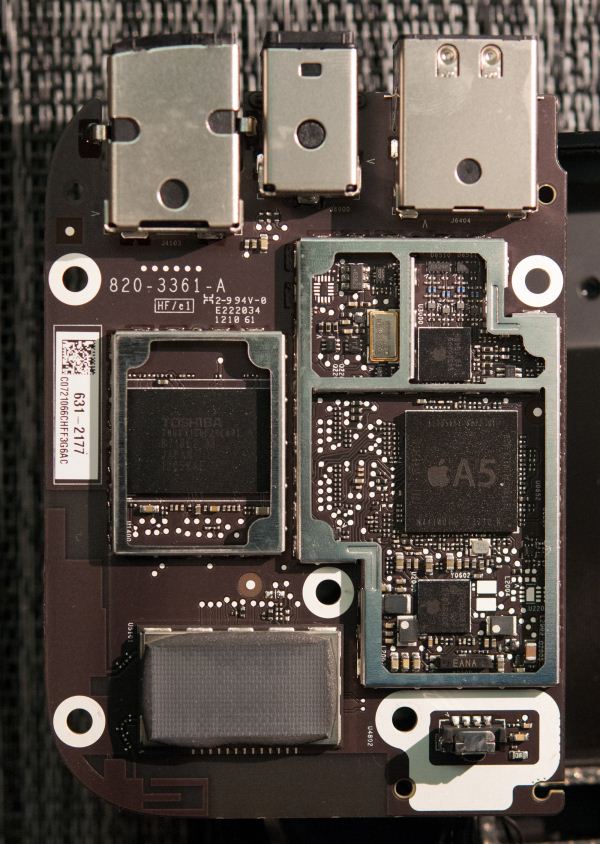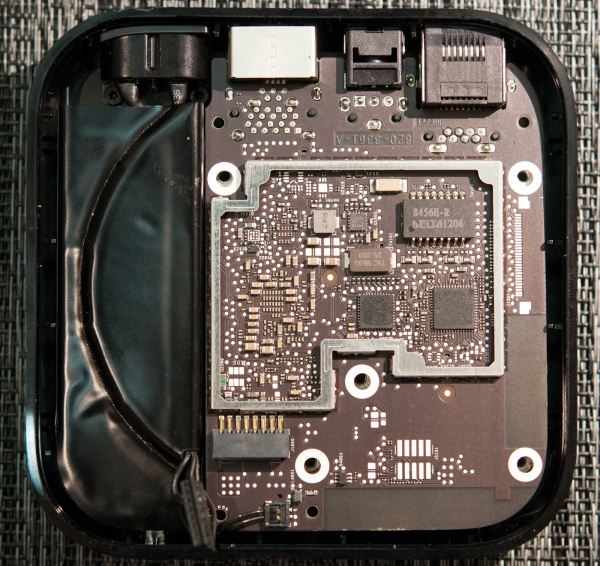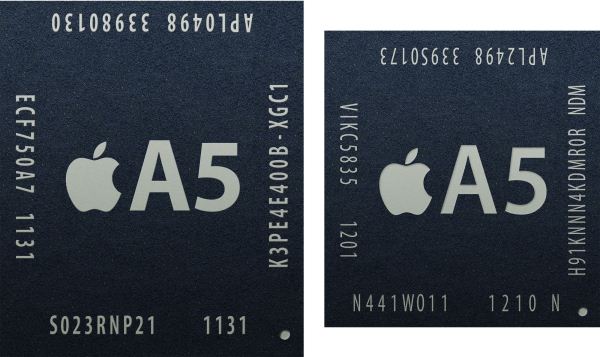Apple TV 3 (2012) Short Review - 1080p and better WiFi
by Brian Klug on March 21, 2012 4:21 PM ESTWhile most of the attention this previous week has been focused on Apple's A5X SoC inside the iPad (3rd Gen), the other Apple-SoC news is that of the S5L8942 or A5 revision 2 inside the Apple TV 3, and iPad2,4. In the case of the Apple TV 3, this A5 consists of a single core ARM Cortex A9, and likely the same PowerVR SGX543 GPU, though Apple hasn't stated how many GPU cores are enabled on this particular variant. We originally speculated that this might be a harvested die with an ARM core or SGX 543 core disabled, and until someone X-rays the package it's hard to know for sure. At this point we also don't know anything about what clocks the A5R2 inside Apple TV 3 is running.
In an attempt to figure this out, I decided to disassemble the Apple TV 3 I purchased to see what's different. Taking the Apple TV 3 apart is the same procedure as the last model. The bottom rubberized plastic cup pops off easily enough with a spudger, then there are some Torx bits securing a metal heatspreader to the PCB. Remove this, disconnect the power supply, and you're basically done. Interestingly enough, nearly every package and EMI can has a thermal pad on top and bottom in the Apple TV 3. I haven't found that the new revision gets warm at all (in fact, just like the previous revision it barely gets warm to the touch), but clearly thermals were a consideration here.
Inside the Apple TV 3 things are arranged the same way as the previous model, with one big PCB sitting next to the power supply. With the EMI cans off, you can see that the second unused NAND pads and area have been removed, and in its place is one Toshiba 8 GB NAND device. To the left of it is the device's WLAN + BT 4.0 combo device, whose EMI cans are soldered on. iFixit has since disassembled an Apple TV 3 as well, and found BCM4330 inside, a choice which isn't surprising at all considering Apple's affinity for Broadcom combo chips. Note that there are two RF chains coming from the device, and two antennas, as opposed to the Apple TV 2's one.
Below that we get the new A5, its PMIC to the left, marked 338S1040-A5, and to the right another Apple-branded package marked 343S0479 which previously was on the other side of the PCB in the Apple TV 2. The markings on top of the A5 (we're looking at the DRAM PoP here, actually) indicate a single Hynix 32-bit 512 MB LPDDR2 device, up from the 256 MB of LPDDR2 in the Apple TV 2.
| A5 Comparisons | |||||||||
| SoC | X | Y | Aspect Ratio (long/short) | Marking | |||||
| A5R1 (S5L8940) | 14.3 mm | 16.7 mm | 1.17 | APL0498 | |||||
| A5R2 (S5L8942) | 13.02 mm | 14.02 mm | 1.07 | APL2498 | |||||
If you've had to stare at the A5 in the iPad 2 or iPhone 4S as much as I have, what should strike you immediately is that its aspect ratio is changed - it's more square than the A5 we've seen before. I measured this package and found that aspect ratio change to be the case. Interestingly enough the A5 in Apple TV 3 is slightly smaller than the iPad 2 / iPhone 4S A5, at 13.02 mm x 14.02 mm. This is as opposed to a package size of 16.7 x 14.3 mm for the A5 we've seen before. Package size alone isn't enough to draw conclusions from about whether this is an entirely new design - it's entirely possible that Apple has simply removed unused pads/balls and repackaged the A5.
One of our readers put together photos of the new A5 based on our package photo (and also put together awesome images of the A4 and A5) for Wikipedia, which really illustrates just how changed the aspect ratio is. I put together a to-scale side by side with the two A5 packages above.
The reverse side of the PCB is less interesting. Here we see the SMSC9730 HSIC USB 2.0 to 10/100 Ethernet controller, Delta Electronics magnetics for the Ethernet jack, and another package whose markings I couldn't make out but seems to have been present on Apple TV 2. There's also the same 30-pin dock port pads in the same place.
Finally, the Apple TV 3 contains the same 3.4V, 1.75A (~6 W) power supply as the previous model. In actual use, I've never seen either the Apple TV 2 or 3 use more than 3 watts while decoding 720p or 1080p video. The corresponding bump in output resolution, SoC, and WLAN stack doesn't seem to have changed power draw at all, or at least not enough that I can measure it on the Kill-A-Watt P4460 which only reports down to 1 watt of precision.



















37 Comments
View All Comments
nfineon - Wednesday, March 21, 2012 - link
This is exactly the review I was hoping to find, with a more technical explanation of the hardware underpinnings that Apple doesn't really care to advertise. I personally have 6 Apple TV's throughout the house in all the key rooms and we get tremendous usage out of the Apple TV. Sitting at the dinner table together being able to instantly share our photos and videos via airplay is very nice, but a lot of people also don't realize that you can facetime on the big screen using the airplay mirroring function (try FaceTime on a 100" Projector/LCD and your mother won't ever want to use the small screen again).It's good to hear the antenna gain as improved, and i was really really hoping they would bump up to 2 spacial streams to get us 130 mb/s as Airplay of 1080p videos takes 2-3 times longer to load from the iPhone 4s camera as compared to the traditional 720p. That would also necessitate a bump up in all the iPad/iPhone devices as well given that all of them are also limited to 65 mb/s.
But the #1 usage of the Apple TV's in our house is in streaming our movie/show collection from our Synology NAS in any format. You can't do this with the default firmware, which is why we use the FireCore firmware that keeps the same interface and functions as the original Apple TV while adding the ability to stream from any network device in any format. Also lets you install XBMC, plex and a few other handy tools if you want to go the extra mile but that alone has made the Apple TV increase in value considerably!
Brian Klug - Thursday, March 22, 2012 - link
I was hoping for 2 spatial stream WLAN connectivity as well, unfortunately it just isn't here yet.No doubt future revisions of the Apple TV will use either BCM43241 (which is 2x2:2 and dual-band), instead of the direct BCM4330 successor, BCM4334 (which is still 1 spatial stream, but built on 45nm instead of 4330's 65nm).
-Brian
Shaun-T - Thursday, March 22, 2012 - link
What I want to know is, why doesn't Apple allow the refresh rate to be 24fps on the Apple TV 3? I read somewhere that the Apple TV 2 only output at 25 or 30fps as 720p/24 wasn't an official standard, but 1080p/24 is.So now we have a device that supports 1080p and the content sold on iTunes is 1080p/24. As BluRay players and and modern HD televisions use this, I don't understand why the the Apple TV 3 only outputs at 25 or 30fps. In either of those refresh rates, you get a stutter every second or so when playing 24fps content. It's really annoying.
MGSsancho - Thursday, March 22, 2012 - link
This device is not for what apple calls videohpines who wan to play BD ISOs, DVD ISOs and the llike. It is designed to play anything found on iTunes. If you can get other stuff to play then that is just the gravy on top. For things that are actully useful (at least on current offerings) we are forced to jailbreak it. :)cjs150 - Friday, March 23, 2012 - link
What an incredible oversite (bit like Apple advertising the Ipad 3 as 4G in Europe when it is not).But given that Intel are/were (what is latest position) incapable of producing a chip which outputed at the correct frame rate either (unlike AMD) why should we be surprised.
BD frame rate are not exactly an obscure or new standard!
I guess I will just drop this off my list of things to buy at least until someone jailbreaks it and gets the right frame rate and XBMC on it
solipsism - Saturday, March 24, 2012 - link
Why doesn't Europe follow the ITU's definition of 4G?alpha64 - Friday, March 23, 2012 - link
Your comment in the third page, which reads:In addition, the Apple TV 3 also moves from Broadcom's BCM4329 802.11a/b/g/n and BT 2.0+EDR combo chip to BCM4330 802.11a/b/g/n and BT 4.0 combo chip which we've seen in the iPad 2, iPhone 4S, and countless other mobile devices.
Should say "we've seen in the iPad 3, iPhone 4S, ..."
The iPad 2 had the same BCM4329 as the iPad and iPhone 4:
http://www.ifixit.com/Teardown/iPad-2-Wi-Fi-Teardo...
jpcuve - Monday, March 26, 2012 - link
I purchased one too. Since the last upgrade it plays all my movies correctly (600+), with the subtitles.locust76 - Tuesday, March 27, 2012 - link
I have the new Apple TV and a 40-inch 1080p Sony LCD, and I definitely notice a new sharpness and realism to the images and video from iTunes.I think it's also worth mentioning what this thing can do outside of the iTunes ecosphere: I ripped the Star Wars Ep 4 Blu-Ray and compressed it down to iTunes-level specifications, but with almost 10 Mbit/s video bitrate and DD 5.1.
The Apple TV handled it with no problem, save for buffering issues which prevented me from skipping wildly throughout the movie without longer pauses. However, when the movie was playing, it played without stuttering with exceptional picture quality, considering I was running a video stream through it that was probably double Apple's intended bitrate...
kwrzesien - Wednesday, March 28, 2012 - link
Is this with wired Ethernet or Wi-Fi?